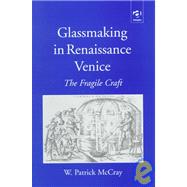Glassmaking in Renaissance Venice: The Fragile Craft
, by McCray,W. Patrick- ISBN: 9780754600503 | 0754600505
- Cover: Hardcover
- Copyright: 2/6/2017
The transformation of the Venetian glass industry during the Renaissance was not only a technical phenomenon, but also a social one. In this volume, Patrick McCray examines the demand, production and distribution of glass and glassmaking technology during this period and evaluates several key topics, including the nature of Renaissance demand for certain luxury goods, the interaction between industry and government in the Renaissance, and technological change as a social process. McCray places in its broader economic and cultural context a craft and industry that has been traditionally viewed primarily through the surviving artefacts held in museum collections.McCray explores the social and economic context of glassmaking in Venice, from the guild and state level down to the workings of the individual glass house. He tracks the dissemination of Venetian-style glassmaking throughout Europe during the sixteenth and seventeenth centuries and its effects on Venice's glass industry. Integrating evidence from a wide variety of sources - written documents such as shop records and recipe books, pictorial representations of glass and glassmaking, and the careful physical and chemical analysis of glass pieces that have survived to the present - he examines the relation between consumer demand and technological change. In the process, he traces the organizational changes that signified a transition from an older and more traditional manner of 'artisan' manufacture to a modern, 'factory-style' manner of production.







